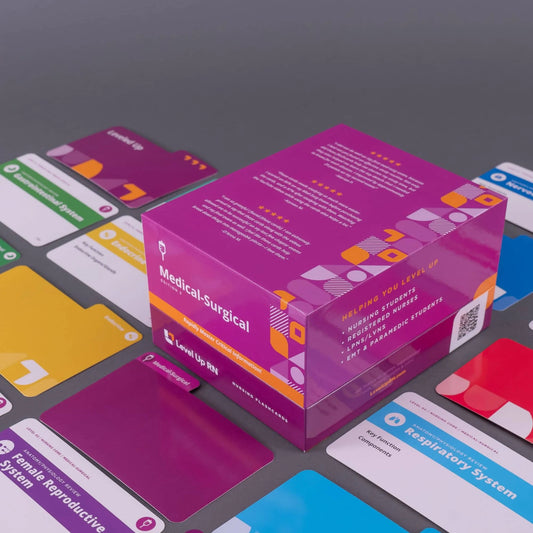Med-Surg - Renal System, part 4: Polycystic Kidney Disease, Glomerulonephritis
Updated: Cathy ParkesPolycystic Kidney Disease (PKD), including the pathophysiology associated with this disorder, signs/symptoms, and treatment of PKD. Glomerulonephritis and explains the pathophysiology, signs/symptoms, labs, diagnosis, treatment, and nursing care for patients with this disorder.
Full Transcript: Med-Surg - Renal System, part 4: Polycystic Kidney Disease, Glomerulonephritis
Full Transcript: Med-Surg - Renal System, part 4: Polycystic Kidney Disease, Glomerulonephritis
Hi. I'm Cathy with Level Up RN. In this video, I will be talking about polycystic kidney disease and glomerulonephritis. If you are following along with Level Up RN medical surgical nursing flashcards, be sure to pay close attention to the old red text on these cars because there are several key important points you have to know about these conditions. At the end of the video, I'm going to give you guys a quiz to test your knowledge of some of the key points I'll be covering in this video, so definitely stay tuned for that. Polycystic kidney disease is an autosomal dominant genetic disorder that causes the formation of fluid-filled cysts in the kidneys. And these cysts will compress and replace the healthy kidney tissue, and that results in decreased kidney function and eventually causes kidney failure. So signs and symptoms of this disorder include abdominal distension, flank or back pain, hypertension, and hematuria, so blood in the urine due to rupturing of the cyst. In terms of treatment, treatment is largely supportive because there is no cure for this condition. Medications that can be used include analgesics, antibiotics for infection, as well as ACE inhibitors or ARBs to help manage hypertension. And then, in terms of procedures, dialysis can be used. The patient may require a nephrectomy, so removal of the kidney, and then a kidney transplant will be necessary for renal failure.
Next, let's talk about glomerulonephritis, which is inflammation of the glomeruli. So this often follows a streptococcal infection, so a strep throat infection. The pathophysiology behind this disorder is that we have antigen-antibody complexes, which are collecting in the glomeruli, and that is causing inflammation and cell destruction, and that is making the glomeruli not able to filter the blood well. So we end up with a decrease in GFR. And that means that fluid is backing up in the body and we have a decrease in urine output. In addition, we have increased membrane permeability because of the destruction there, and that's allowing blood and protein to pass into the urine, so signs and symptoms of this condition will include oliguria, so that means a little urine because we're not having a lot of urine. All that fluid is backing up in the body. In addition, we're going to have signs and symptoms of hypervolemia, so fluid volume excess. So this will include hypertension, dyspnea, crackles, as well as edema. In addition, the patient will likely have brown cola-colored urine because of blood being in the urine, so that microscopic blood is going to discolor the patient's urine output.
Let's now talk about the labs associated with glomerulonephritis. So we're going to have elevation in creatinine and BUN because we have kidney dysfunction. We're also going to see an increase in white blood cells as well as ESR and CRP because inflammation is present, and then we're going to have a positive antistreptolysin O titer, so ASO titer, because the patient will have antibodies for that strep throat infection that preceded glomerulonephritis. In terms of urinalysis, because we are losing protein and blood in the urine, we're going to have proteinuria and hematuria as well as an increase in urine-specific gravity. And then a throat culture will be positive for group A beta-hemolytic streptococcus, which is the strep throat infection. Definitive diagnosis of glomerulonephritis can be done with a renal biopsy. Treatment includes antibiotics to treat the underlying strep infection. In addition, we would give diuretics to get rid of excess fluid and antihypertensive agents as well, and corticosteroids could be used to decrease inflammation. We can also use a plasmapheresis to help filter out those antibody complexes, which are damaging the kidneys, and then dialysis and a kidney transplant may be required for chronic glomerulonephritis. In terms of nursing care, we're going to want to closely monitor our patients' eyes and nose as well as their daily weight, and then we may need to decrease their fluid, sodium, and protein intake until their kidneys heal.
All right. It's time for a quiz. I have three questions for you. First question glomerulonephritis often follows a blank infection. The answer is streptococcal. Question number two, with glomerulonephritis, the patient may have a positive blank titer. The answer is ASO or antistreptolysin O titer. Question number three, a urinalysis of a patient with glomerulonephritis will reveal what two key abnormalities? The answer is hematuria and proteinuria. If you said an elevation in urine-specific gravity, you're not wrong, but really, the key attributes of this disorder include blood and protein in the urine. Okay. That's it. I hope you found the video to be super helpful. Take care and thank you so much for watching.
So signs and symptoms include abdominal distension back or pink-- back or pink vein-- [laughter] back or pink fang. All right. I'm going to stop here. So signs and symptoms of this disorder include abdominal distension, back or pink-- pank flain-- why can't I say it? Back or-- back or flank pain. Back of flank pain. All right. I don't even have to figure out different ways to say this. Slank or back pain. That's what I'm going to do. Okay.


